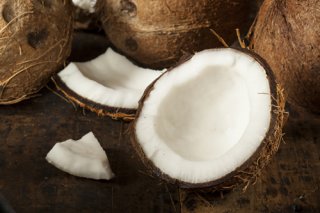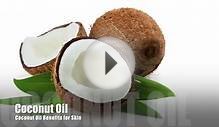
 Crack! The dark, fibrous shell breaks, and fragrant coconut liquid begins to ooze out. Using a sharp knife, you separate the luscious white flesh from its shell; then grate it to make rich, delicious coconut milk. The milk will add delicate flavor and a smooth creamy texture to your lentil soup simmering on the stove.
Crack! The dark, fibrous shell breaks, and fragrant coconut liquid begins to ooze out. Using a sharp knife, you separate the luscious white flesh from its shell; then grate it to make rich, delicious coconut milk. The milk will add delicate flavor and a smooth creamy texture to your lentil soup simmering on the stove.
But it is not only for its taste that the coconut is valued, says The Council of Maharishi Ayurveda Physicians. Coconut is considered a divine plant in the Vedic tradition. Whenever you perform a sacred ceremony like a yagya, a coconut must grace the occasion. Thus, the coconut enjoys the hallowed status of a select few herbs and fruits-like holy basil and amla-in the Vedic tradition.
What's in a Coconut?
A recent research study from the Department of Biochemistry in the University of Kerala states that the fatty-acid composition of coconut changes as it grows. This change in composition is being studied by scientists in many places. But ayurvedic scholars knew many centuries ago that coconut has different properties at different stages of its life.
In the ayurvedic Nighantus or classical texts which talk about raw materials or fruits, the coconut is actually divided into three types of coconuts -
- Baal: tender or baby coconut
- Madhyam: half-mature coconut
- Pakva: fully mature coconut.
The Three Coconuts
Baal or Tender coconut: This type is 90 to 95 percent water. The liquid from this coconut is at its purest and most healing. It is considered the best for its cooling properties, for it is a proven pitta-pacifier. While unclogging the body's channels, tender coconut water lubricates the dryness caused by Ama. It repairs the gastro-intestinal tract, and its Snigdha or sweet quality gives it a Pranaropana-life-restoring-capacity.
Madhyam or Middle-aged coconut: In addition to water, the coconut at this stage has some soft pulp. Madhyam coconuts have less water than tender ones, but more water than mature coconuts. The water is slightly milky at this age. In the classical ayurvedic texts called Raj Nighantus, the middle-aged coconut is said to be the most nutritious. This type generally has more carbohydrates, protein, minerals, phosphorus, and Vitamins A, B, and C than the other two forms.
Mature or Pakva coconut: This type of coconut has firm "meat" or pulp, and very little water. Ancient ayurvedic scholar Bhav Mishra wrote that when a coconut becomes mature, it becomes heavy to digest, and it can also aggravate pitta or vata if the digestive Agni of the individual is low. Mature coconuts can also build up toxic Ama by interfering with digestion. If large quantities of this variety are consumed daily, then a person can suffer hyperacidity, and worse still, elevated cholesterol levels.
Therefore, people who have low Agni or digestive power are not advised to eat mature coconut, unless it is combined with ingredients that balance its negative properties. In the south of India, for instance, a popular way to eat coconut is in the form of chutney. Combined with healthful ingredients like roasted chickpea flour, curry leaves, mustard seeds, and oil, the coconut is used in smaller quantities, and can actually be beneficial.
RELATED VIDEO












